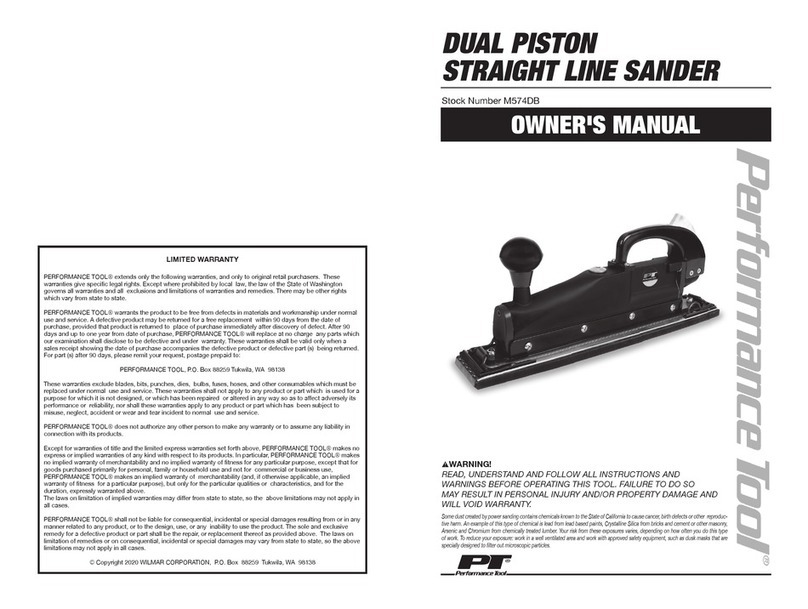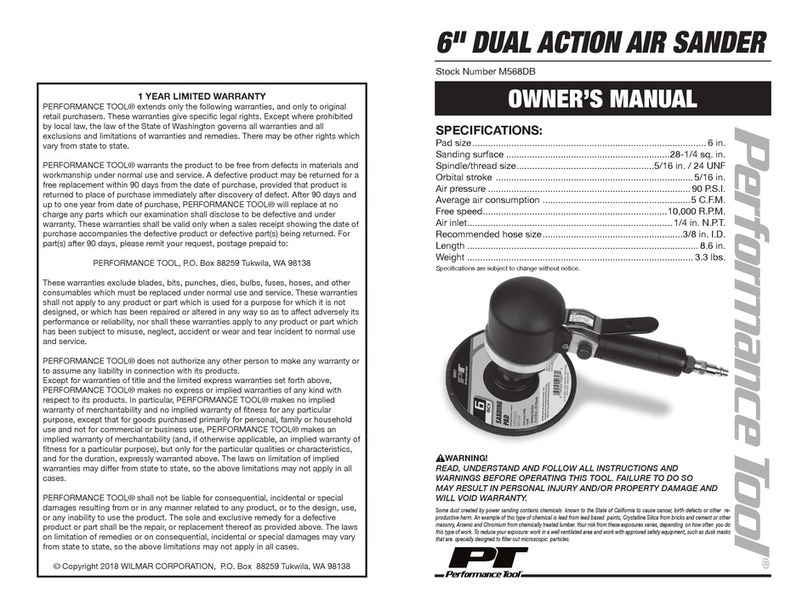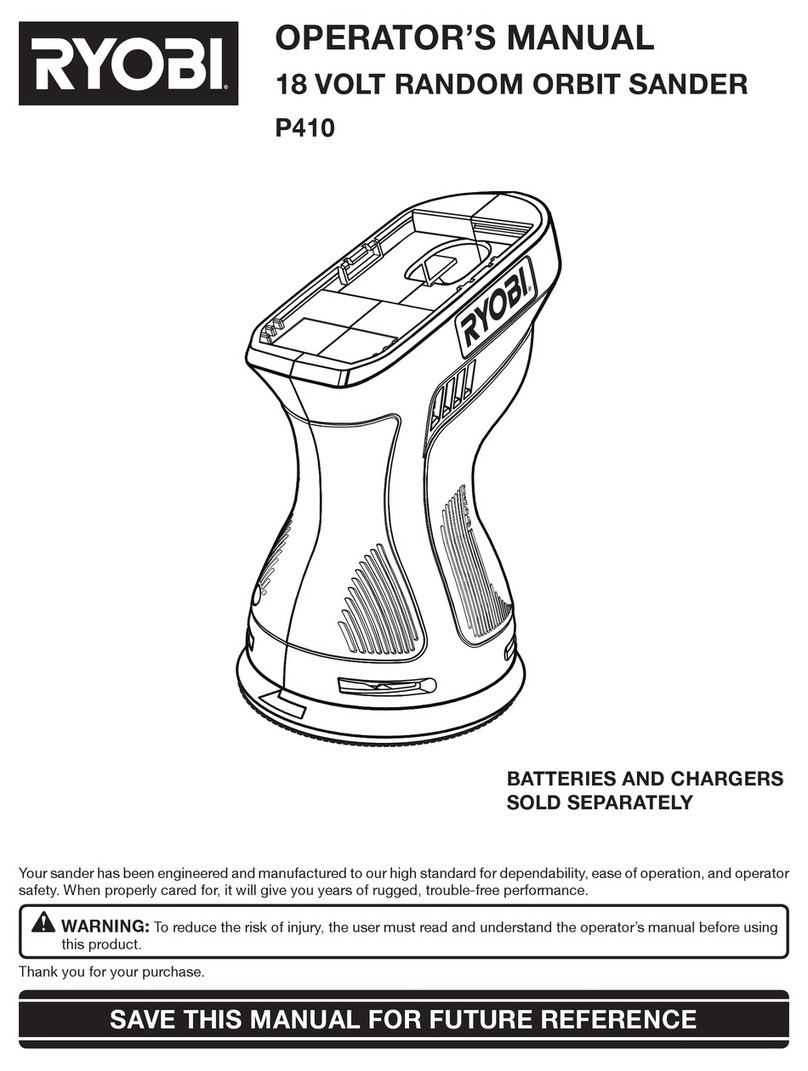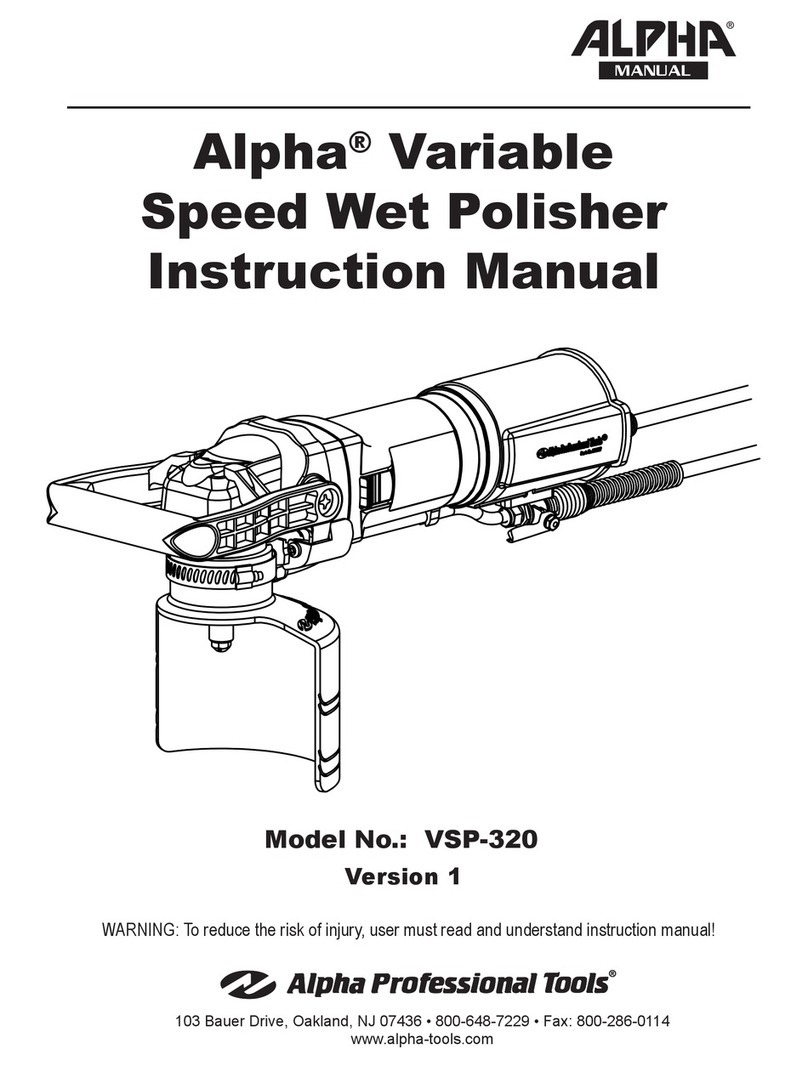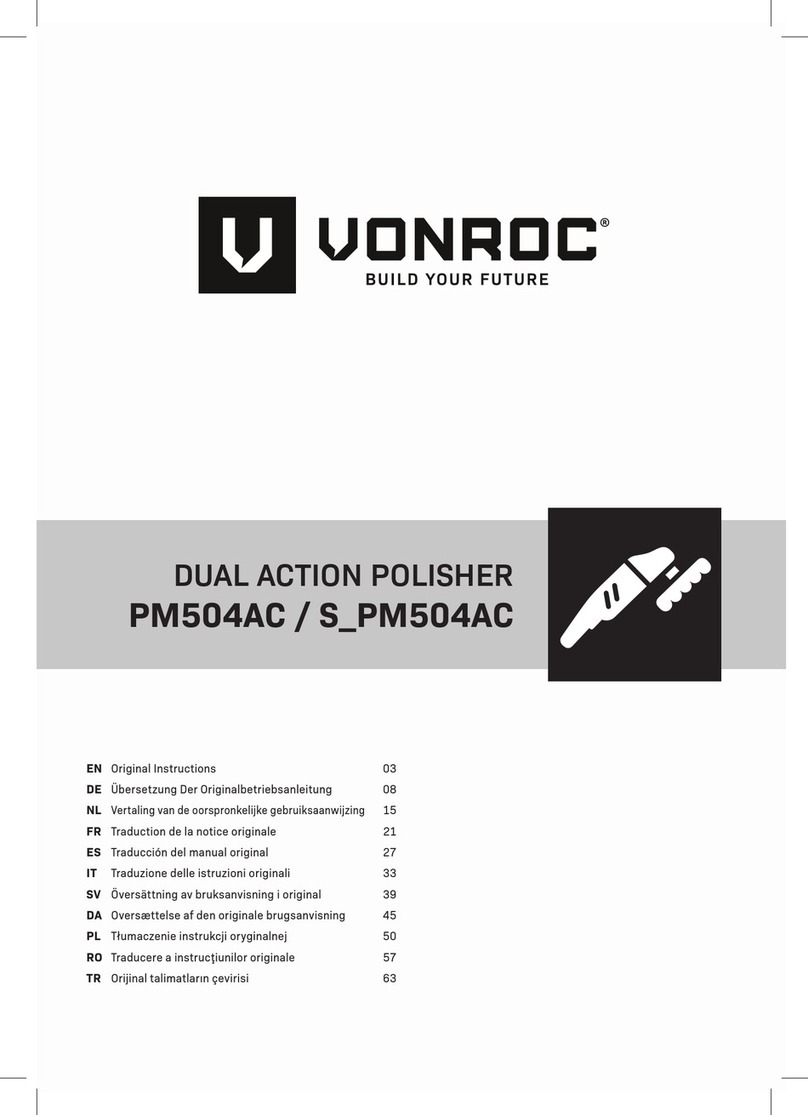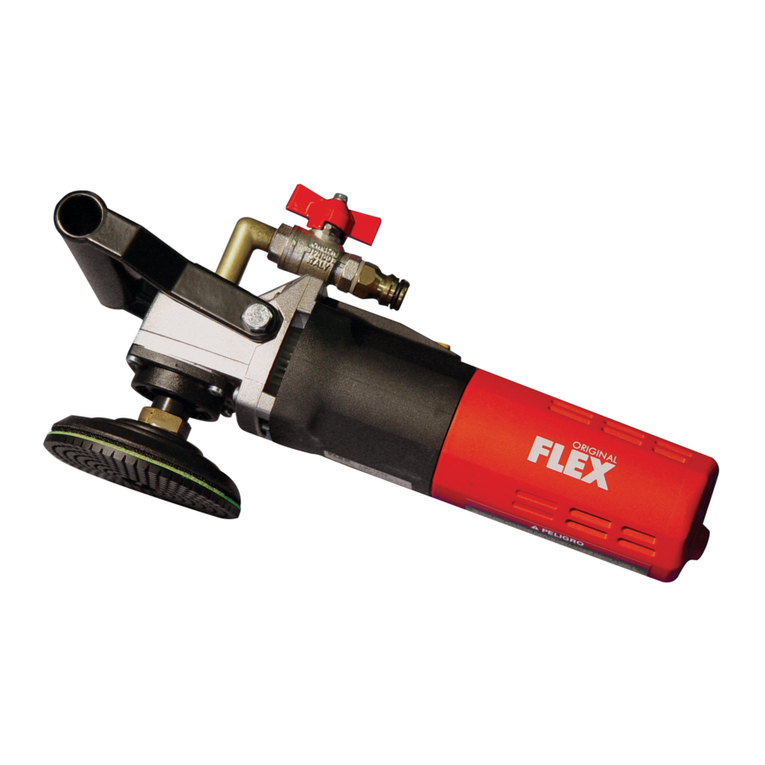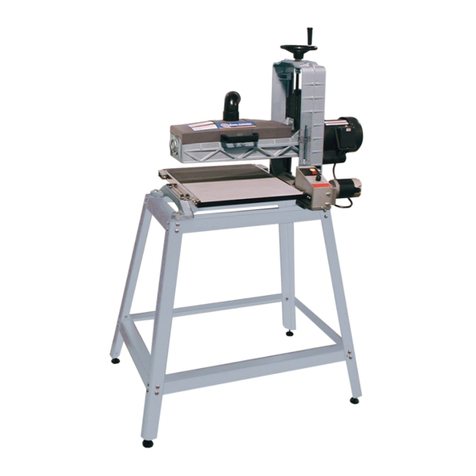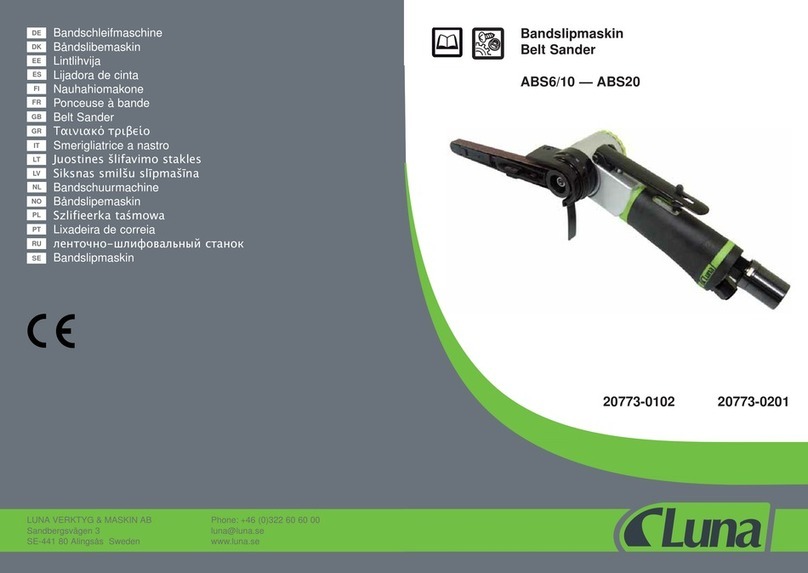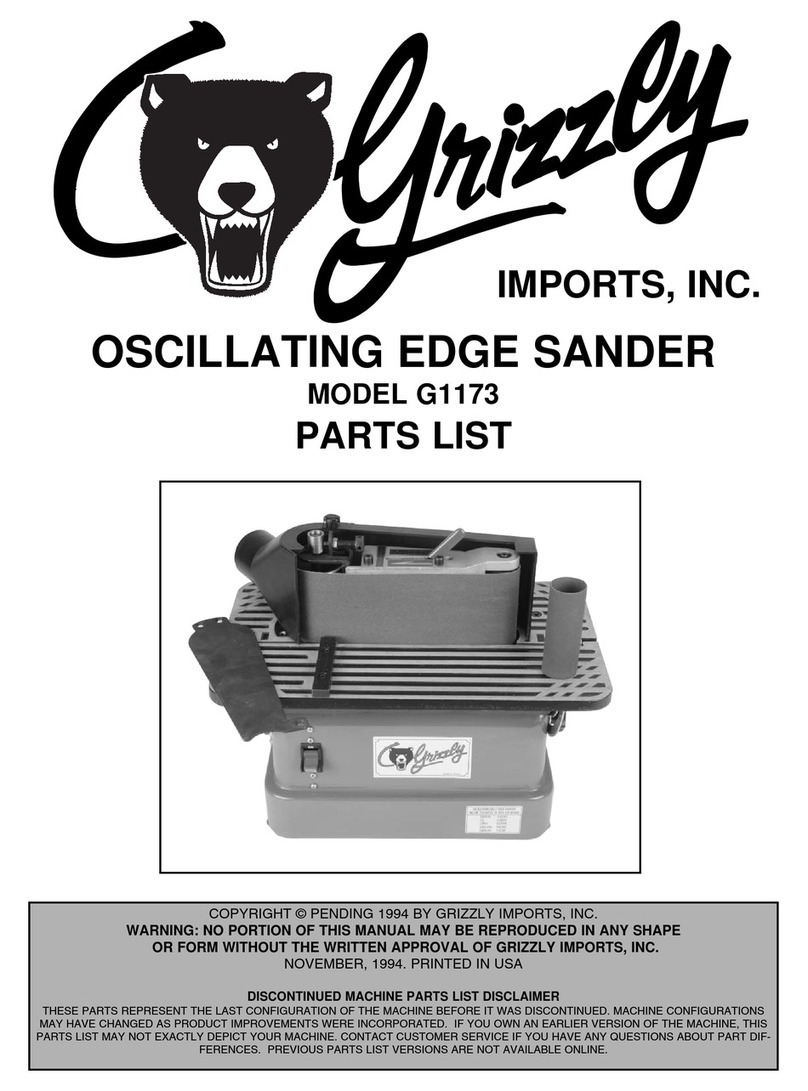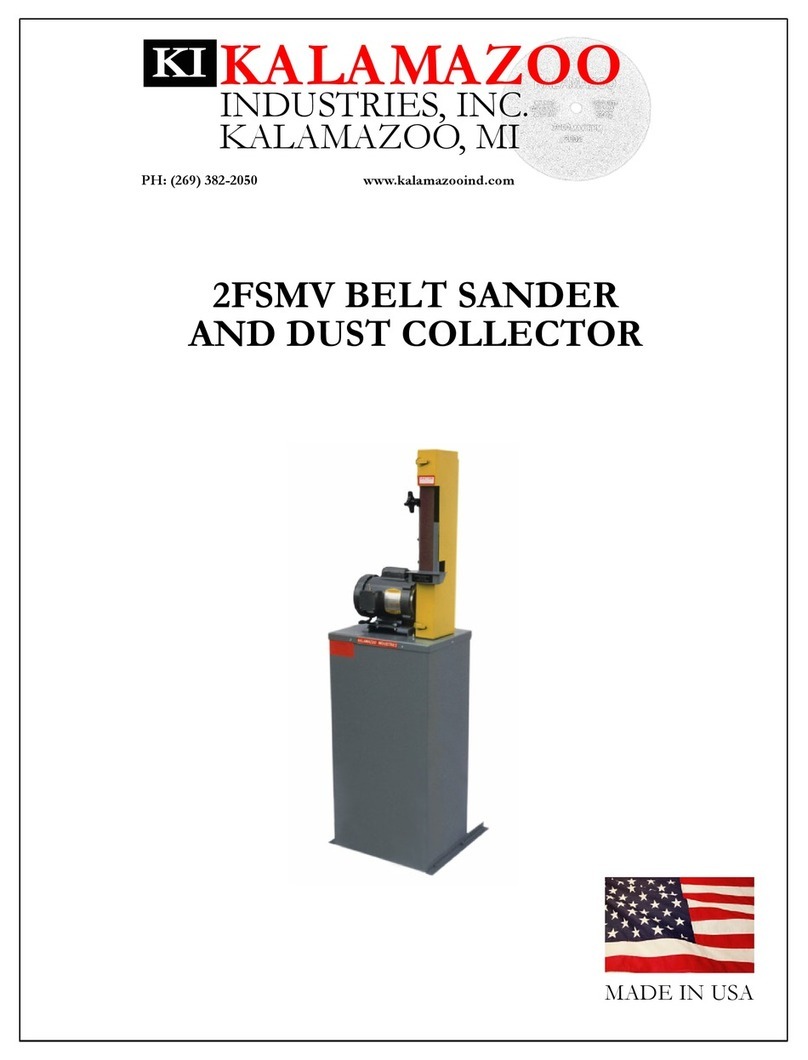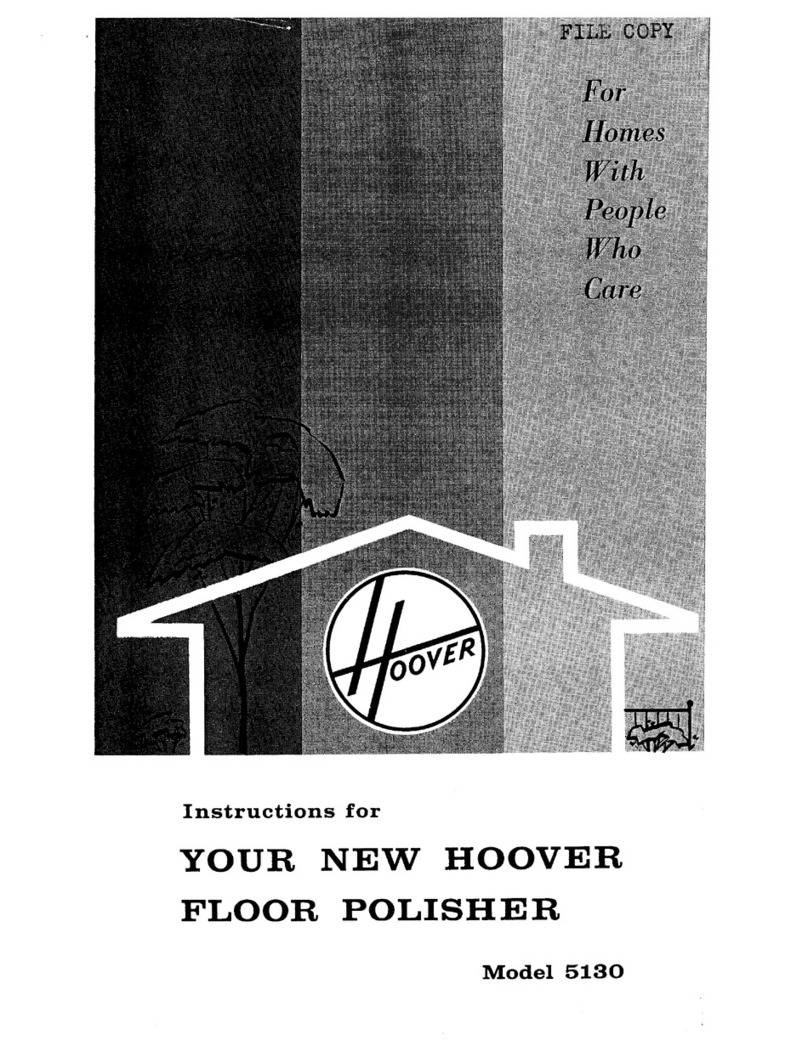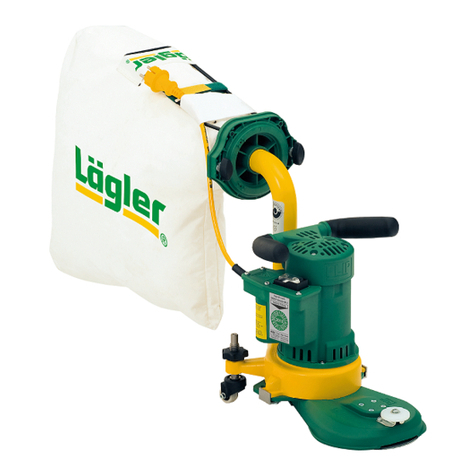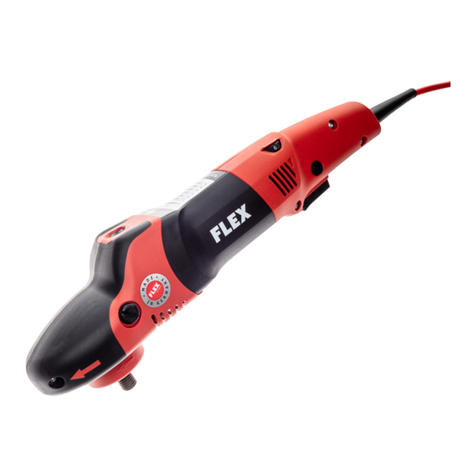PT W50087 User manual

6 IN. RANDOM ORBITAL
POLISHER / SANDER
WARNING!
READ, UNDERSTAND AND FOLLOW ALL INSTRUCTIONS AND
WARNINGS BEFORE OPERATING THIS TOOL. FAILURE TO DO SO
MAY RESULT IN PERSONAL INJURY AND/OR PROPERTY DAMAGE AND
WILL VOID WARRANTY.
Some dust created by power sanding contains chemicals known to the State of California to cause cancer, birth defects or other reproductive
harm. An example of this type of chemical is lead from lead based paints, Crystalline Silica from bricks and cement or other masonry, Arsenic
and Chromium from chemically treated lumber. Your risk from these exposures varies, depending on how often you do this type of work.
To reduce your exposure: work in a well ventilated area and work with approved safety equipment, such as dusk masks that are specially
designed to lter out microscopic particles.
1 YEAR WARRANTY
PERFORMANCE TOOL® extends only the following warranties, and only to original retail purchasers. These
warranties give specific legal rights. Except where prohibited by local law, the law of the State of Washington
governs all warranties and all exclusions and limitations of warranties and remedies. There may be other rights
which vary from state to state.
PERFORMANCE TOOL® warrants the product to be free from defects in materials and workmanship under normal
use and service. A defective product may be returned for a free replacement within 90 days from the date of
purchase, provided that product is returned to place of purchase immediately after discovery of defect. After 90
days and up to one year from date of purchase, PERFORMANCE TOOL® will replace at no charge any parts which
our examination shall disclose to be defective and under warranty. These warranties shall be valid only when a sales
receipt showing the date of purchase accompanies the defective product or defective part (s) being returned. For
part (s) after 90 days, please remit your request, postage prepaid to:
PERFORMANCE TOOL, P.O. Box 88259 Tukwila, WA 98138
These warranties exclude blades, bits, punches, dies, bulbs, fuses, hoses, and other consumables which must be
replaced under normal use and service. These warranties shall not apply to any product or part which is used for a
purpose for which it is not designed, or which has been repaired or altered in any way so as to affect adversely its
performance or reliability, nor shall these warranties apply to any product or part which has been subject to misuse,
neglect, accident or wear and tear incident to normal use and service.
PERFORMANCE TOOL® does not authorize any other person to make any warranty or to assume any liability in
connection with its products.
Except for warranties of title and the limited express warranties set forth above, PERFORMANCE TOOL® makes no
express or implied warranties of any kind with respect to its products. In particular, PERFORMANCE TOOL® makes
no implied warranty of merchantability and no implied warranty of fitness for any particular purpose, except that for
goods purchased primarily for personal, family or household use and not for commercial or business use,
PERFORMANCE TOOL® makes an implied warranty of merchantability (and, if otherwise applicable, an implied
warranty of fitness for a particular purpose), but only for the particular qualities or characteristics, and for the
duration, expressly warranted above.
The laws on limitation of implied warranties may differ from state to state, so the above limitations may not apply in
all cases.
PERFORMANCE TOOL® shall not be liable for consequential, incidental or special damages resulting from or in any
manner related to any product, or to the design, use, or any inability to use the product. The sole and exclusive
remedy for a defective product or part shall be the repair, or replacement thereof as provided above. The laws on
limitation of remedies or on consequential, incidental or special damages may vary from state to state, so the above
limitations may not apply in all cases.
© Copyright 2019 WILMAR CORPORATION, P.O. Box 88259 Tukwila, WA 98138
Item Number W50087
OWNER’S MANUAL

Stator Screw
Stator
Fan Shroud
Housing
Carbon
Brush
Carbon
Brush Holder
Speed
Control
Switch
Spring
Internal
27
28
29
30
31
32
33
34
35
36
37
38
Rear Housing Screw
Cord Sleeve
Power Cord
Side Handle
Bearing Nsk688
Gear Retaining Ring
Face Gear
Gearbox Cap
Gearbox Cap Screw
Woodruff Key
Spindle
Bearing
1 2
TOOL FEATURES
TECHNICAL SPECIFICATIONS:
Technical specifications are subject to change without notice.
This instruction manual is intended for your benefit. Please read and follow the safety, installation, maintenance
and troubleshooting steps described within to ensure your safety and satisfaction. The contents of this instruction
manual are based upon the latest product information available at the time of publication. The manufacturer
reserves the right to make product changes at any time without notice.
SAFETY GUIDELINES / DEFINITIONS
WARNING: Read and understand this entire instruction manual before attempting to assemble, install, .
operate or maintain this product. Failure to comply with the instructions may result in serious personal .
injury and/or property damage!
The following signal words are used to emphasize safety
warnings that must be followed when using this product:
PARTS LIST
No. Description No. Description No. Description
Replacement bonnet / pad set..................................................................W50087A
REPLACEMENT PARTS AVAILABLE:
22
21
123
5
4
6
7
8
9
10
11
12
13
18
20
19
25
24
27 28
29
17
16
15
14
26
23
46
45
44
42
41
40
47
39
38
37
36
34
33
32
31
35
30
43
CAUTION:
Indicates a potentially hazardous
situation that, if not avoided, MAY result in
minor or moderate injury.
NOTICE Indicates important information,
which if not followed, MAY cause damage to
equipment.
DANGER:
Indicates an imminently hazardous
situation that, if not avoided, WILL result in
death or serious injury.
WARNING:
Indicates a potentially hazardous
situation that, if not avoided, COULD result in
death or serious injury.
WARNING
Follow all safety precautions whenever diagnosing or
servicing the tool. Disconnect power supply before service.
No-load speed: .......................................................................... 2000 - 6400 RPM
Amperage: ......................................................................................................5.7A
Max accessory diameter: ...............................................................6 in. (152mm)
Spindle thread: ......................................................................................5/8 in.-11
Motor: ...............................................................................................120 V ~ 60hz
1
2
3
4
5
6
7
8
9
10
11
12
13
14
15
16
17
18
19
20
21
22
23
24
25
26
Gearbox Cover
Screw
Screw
Screw
Gearbox
Lock Nut
Pinion Gear
Bearing
Bearing Spacer
Fan
Rotor
Magnetic Ring
Bearing
IMPORTANT SAFETY INFORMATION
1. Always use common sense and pay particular attention
to all the DANGER, WARNING, CAUTION and NOTICE
statements of this manual. The safety instructions provided
are not intended to cover all possible conditions and
practices that may occur when operating, maintaining
and cleaning power tools.
2. Observe work area conditions. Do not use machines or
power tools in damp or wet locations. Don’t expose to
rain. Keep work area well lighted. Do not use electrically
powered tools in the presence of ammable gases or
liquids. Do not bring combustible materials near the tools.
Power tools create sparks, which may ignite the dust or
fumes. Keep work area clean and well lit. Cluttered work
areas invite accidents.
3. Wear personal protective equipment. Depending on
application, use face shield, safety goggles or safety
glasses. as appropriate, wear dust mask, hearing
protectors, gloves and workshop apron capable of
stopping small abrasive or workpiece fragments. the
eye protection must be capable of stopping ying
debris generated by various operations. The eye
protection must be capable of stopping ying debris
generated by various operations. The dust mask or
respirator must be capable of ltering out particles
generated by your operation. Prolonged exposure to
high intensity noise may cause hearing loss.
4.
Keep bystanders, children and visitors away while
operating this product. Distractions can cause you
to lose control. Anyone entering the work area must
wear personal protective equipment. Fragments of
workpiece or of a broken accessory may y away and
cause injury beyond immediate area of operation.

43
5. Stay alert. Watch what you are doing, and use common
sense when operating this product. Do not use this
product while tired or under the inuence of drugs,
alcohol, or medication. A moment of inattention while
operating this product may result in serious personal
injury. Keep proper footing and balance at all times.
Do not reach over or across running machines, hoses,
cords, etc.
6. Dress properly. Do not wear loose clothing or jewelry.
Keep your hair, clothing, and gloves away from moving
parts. Loose clothes, jewelry or long hair can be caught
in moving parts.
7. Work Safe. Operate tool a safe distance from yourself
and others in the work area. Do not run the power tool
while carrying it at your side. Accidental contact with the
spinning accessory could snag your clothing, pulling
the accessory into your body. Never lay the power tool
down until the accessory has come to a complete stop.
The spinning accessory may grab the surface and pull
the power tool out of your control. Keep proper footing
and balance at all times. Do not overreach, especially
on ladders. Be certain ladders being used are sturdy,
stable, on a rm surface and erected as safe working
angles. Do not reach over or across running machines,
hoses, cords, etc.
8. Inspect before every use; do not use if parts are loose
or damaged.
9. Do not alter this product in any way.
10.
Use the right tool for the job. Do not attempt to force
a small tool or attachment to do the work of a larger
industrial tool. Don’t use a tool whose performance is not
adequate for your work. Do not modify this tool and do not
use this tool for a purpose for which it was not intended.
11. Power tool plugs must match the outlet. Never modify
the plug in any way. Do not use any adapter plugs with
earthed (grounded) power tools. Unmodied plugs and
matching outlets will reduce risk of electric shock.
12. People with pacemakers should consult their
physician(s) before use. Electromagnetic elds in close
proximity to heart pacemaker could cause pacemaker
interference or pacemaker failure. In addition, people
with pacemakers should:
• Avoid operating alone.
• Do not use with power switch locked on.
• Properly maintain and inspect to avoid electrical shock
.
• Any power cord must be properly grounded. Ground
Fault Circuit Interrupter (GFCI) should also be
implemented – it prevents sustained electrical shock.
13. Avoid body contact with earthed or grounded surfaces
such as pipes, radiators, ranges and refrigerators.
There is an increased risk of electric shock if your body
is earthed or grounded.
14. Do not expose power tools to rain or wet conditions.
Water entering a power tool will increase the risk of
electric shock.
15. Do not abuse the cord. Never use the cord for carrying,
pulling or unplugging the power tool. Position the cord
clear of the spinning accessory. If you lose control, the
cord may be cut or snagged and your hand or arm may
be pulled into the spinning accessory. Keep cord away
from heat, oil, sharp edges or moving parts. Damaged
or entangled cords increase the risk of electric shock.
16.
When operating a power tool outdoors, use an extension
cord suitable for outdoor use. Use of a cord suitable for
outdoor use reduces the risk of electric shock.
17. If operating a power tool in a damp location is
unavoidable, use a ground fault circuit interrupter
(GFCI) protected supply. Use of a GFCI reduces
the risk of electric shock.
18. Use power tool ONLY on adequately rated circuits
to avoid overheating of electrical systems.
19. Prevent accidental starting. Ensure switch is in the
“OFF” position before connecting to power source
and/or battery pack, picking up or carrying the tool.
Carrying power tools with your nger on the switch
or energizing power tools that have the switch “ON”
invites accidents.
20. Do not use the power tool if the switch does not
turn it on and off. Any power tool that cannot be
controlled with the switch is dangerous and must
be repaired.
21. Have your power tool serviced by a qualied repair
person using only identical replacement parts.
This will ensure that the safety of the power tool is
maintained. Follow instructions in the Maintenance
section of this manual. Use of unauthorized parts
or failure to follow Maintenance Instructions may
create a risk of shock or injury.
22.
Maintain labels and nameplates on the tool. These
carry important safety information. If unreadable or
missing, contact Performance Tool® for a replacement.
23. Disconnect the plug from the power source before
making any adjustments or changing accessories.
Such preventive safety measures reduce the risk of
starting the power tool accidentally.
24.
Maintain power tools. Check for misalignment or
binding of moving parts, breakage of parts and any
other condition that may affect the power tool’s
operation. Regularly clean the power tool’s air vents.
The motor’s fan will draw the dust inside the housing
and excessive accumulation of powdered metal
may cause electrical hazards. If damaged, have the
power tool repaired before use. Many accidents are
caused by poorly maintained power tools.
25. Use the power tool, accessories and tool bits etc.
in accordance with these instructions, taking into
account the working conditions and the work to be
performed. Use of the power tool for operations
different from those intended could result in a
hazardous situation.
26.
Do not use accessories which are not specically
designed and recommended by the tool manufacturer.
Just because the accessory can be attached to your
power tool, it does not assure safe operation.
27. The rated speed of the accessory must be at least
equal to the maximum speed marked on the power
tool. Accessories running faster than their RATED
SPEED can break and y apart.
28. The outside diameter and the thickness of your
accessory must be within the capacity rating of
your power tool. Incorrectly sized accessories
cannot be adequately guarded or controlled.
29. The arbor size of wheels, anges, backing pads or
any other accessory must properly t the spindle of
the power tool. Accessories with arbor holes that
do not match the mounting hardware of the power
tool will run out of balance, vibrate excessively and
may cause loss of control.
30.
Do not use excessively oversized sanding disc
paper. Follow manufacturer’s recommendations
when selecting sanding paper. Larger sanding
paper extending beyond the sanding pad presents a
laceration hazard and may cause snagging, tearing
of the disc or kickback.
abrasive wheel is snagged or pinched by the workpiece,
the edge of the wheel that is entering into the pinch
point can dig into the surface of the material causing
the wheel to climb out or kick out. The wheel may either
jump toward or away from the operator, depending
on direction of the wheel’s movement at the point of
pinching. Abrasive wheels may also break under these
conditions. Kickback is the result of power tool misuse
and/or incorrect operating procedures or conditions and
can be avoided by taking proper precautions as given below.
1.
Maintain a rm grip on the power tool and position
your body and arm to allow you to resist kickback forces.
always use auxiliary handle, if provided, for maximum
control over kickback or torque reaction during start-up.
The operator can control torque reactions or kickback
forces, if proper precautions are taken.
2. Never place your hand near the rotating accessory.
Accessory may kickback over your hand.
3. Do not position your body in the area where power
tool will move if kickback occurs. Kickback will propel
the tool in direction opposite to the wheel’s movement
at the point of snagging.
4. Use special care when working corners, sharp
edges etc. avoid bouncing and snagging the accessory.
Corners, sharp edges or bouncing have a tendency to
snag the rotating accessory and cause loss of control
or kickback.
5. Do not attach a saw chain woodcarving blade
or toothed saw blade. Such blades create frequent
kickback and loss of control.
42. VIBRATION WARNING: This tool vibrates during
use. Repeated or long-term exposure to vibration
may cause temporary or permanent physical injury,
particularly to the hands, arms and shoulders. To
reduce the risk of vibration-related injury:
1. Anyone using vibrating tools regularly or for an
extended period should rst be examined by a
doctor and then have regular medical check-ups to
ensure medical problems are not being caused or
worsened from use. Pregnant women or people who
have impaired blood circulation to the hand, past
hand injuries, nervous system disorders, diabetes, or
Raynaud’s Disease should not use this tool. If you feel
any medical or physical symptoms related to vibration
(such as tingling, numbness, and white or blue ngers),
seek medical advice as soon as possible.
2. Do not smoke during use. Nicotine reduces the
blood supply to the hands and ngers, increasing the
risk of vibration-related injury.
3. Wear suitable gloves to reduce the vibration effects
on the user.
4. Use tools with the lowest vibration when there is a
choice between different processes.
5. Include vibration-free periods each day of work.
6. Grip tool as lightly as possible (while still keeping
safe control of it). Let the tool do the work.
7. To reduce vibration, maintain the tool as explained
in this manual. If any abnormal vibration occurs,
stop use immediately.
43. The warnings, precautions, and instructions discussed
in this instruction manual cannot cover all possible
conditions and situations that may occur. It must be
understood by the operator that common sense and
caution are factors which cannot be built into this
product, but must be supplied by the operator.
31. Do not allow any loose portion of the polishing bonnet
or its attachment strings to spin freely. tuck away or
trim any loose attachment strings. Loose and spinning
attachment strings can entangle your ngers or snag
on the workpiece.
32. Do not use a damaged accessory. Before each use
inspect the accessory such as abrasive wheels for
chips and cracks, backing pad for cracks, tear or
excess wear, wire brush for loose or cracked wires.
If power tool or accessory is dropped, inspect for
damage or install an undamaged accessory. After
inspecting and installing an accessory, position yourself
and bystanders away from the plane of the rotating
accessory and run the power tool at maximum no-load
speed for one minute. Damaged accessories will
normally break apart during this test time.
33. Do not use accessories that require liquid coolants.
Using water or other liquid coolants may result in
electrocution or shock.
34.
Operations such as grinding, wire brushing, or cutting-off
are not recommended to be performed with this power
tool. Operations for which the power tool was not
designed may create a hazard and cause personal injury.
35. Hold power tool by insulated gripping surfaces only,
when performing an operation where the accessory
may contact hidden wiring or its own cord. An accessory
contacting a “liveˮ wire may make exposed metal parts of
the power tool “live” and shock the operator.
36. Do not depress the spindle lock when starting or during
operation.
37.
Use clamps (not included) or other practical ways to
secure and support the workpiece to a stable platform.
Holding the work by hand or against your body is unstable
and may lead to loss of control and personal injury.
38. Store idle equipment. When not in use, tools must
be stored in a dry location to inhibit rust. Always lock
up tools and keep out of reach of children and other
untrained persons. Switch off all unused electrical tools
when stored. Disconnect battery from unit. Tools are
dangerous in the hands of untrained users.
39. WARNING:
Some dust created by power sanding,
sawing, grinding, drilling, and other construction activities,
contains chemicals known [to the State of California] to
cause cancer, birth defects or other reproductive harm.
Some examples of these chemicals are:
• Lead from lead-based paints.
• Crystalline silica from bricks and cement or other
masonry products.
• Arsenic and chromium from chemically treated lumber.
Your risk from these exposures varies, depending on
how often you do this type of work. To reduce your
exposure to these chemicals: work in a well ventilated
area, and work with approved safety equipment, such
as those dust masks that are specially designed to lter
out microscopic particles. (California Health & Safety
Code § 25249.5, et seq.)
40. WARNING: Handling the cord on this product will
expose you to lead, a chemical known to the State
of California to cause cancer, and birth defects or
other reproductive harm. Wash hands after handling.
(California Health & Safety Code § 25249.5, et seq.)
41.
KICKBACK WARNING: Kickback is a sudden
reaction to a pinched or snagged rotating wheel,
backing pad, brush or any other accessory. Pinching or
snagging causes rapid stalling of the rotating accessory
which in turn causes the uncontrolled power tool to
be forced in the direction opposite of the accessory’s
rotation at the point of the binding. For example, if an

EXTENSION CORDS
1.
Grounded tools require a three wire extension cord. Double
insulated tools can use either a two or three wire extension cord.
2. As the distance from the supply outlet increases, you must
use a heavier gauge extension cord. Using extension cords
with inadequately sized wire causes a serious drop in
voltage, resulting in loss of power and possible tool damage.
(See table A.)
3. The smaller the gauge number of the wire, the greater the
capacity of the cord. For example, a 14 gauge cord can
carry a higher current than a 16 gauge cord. (See table A.)
4. When using more than one extension cord to make up the
total length, make sure each cord contains at least the
minimum wire size required. (See table A.)
5. If you are using one extension cord for more than one tool,
add the nameplate amperes and use the sum to determine
the required minimum cord size. (See table A.)
6. If you are using an extension cord outdoors, make sure it is
marked with the suffix “W-A” (“W” in Canada) to indicate it
is acceptable for outdoor use.
7. Make sure the extension cord is properly wired and in good electrical condition. Always replace a damaged extension
cord or have it repaired by a qualified electrician before using it.
8.
Protect the extension cords from sharp objects,excessive heat, and damp or wet areas.
DOUBLE INSULATED:
TOOLS WITH TWO PRONG PLUGS
1. Tools marked “double insulated” do not require grounding.
They have a special double insulation system which satisfies
OSHA requirements and complies with the applicable standards
of underwriters laboratories, Inc., the Canadian standard
association, and the National electrical code.(See Figure B.)
2. Double insulated tools may be used in either of the 120 volt
outlets shown in the following illustration. (See Figure B.)
GROUNDED TOOLS:
TOOLS WITH THREE PRONG PLUGS
1. Tools marked with “Grounding Required” have a three wire
cord and three prong grounding plug. The plug must be
connected to a properly grounded outlet. If the tool should
electrically malfunction or break down, grounding provides a
low resistance path to carry electricity away from the user,
reducing the risk of electric shock. (See Figure A.)
2. The grounding prong in the plug is connected through the
green wire inside the cord to the grounding system in the
tool. The green wire in the cord must be the only wire
connected to the tool’s grounding system and must never be
attached to an electrically “live” terminal. (See Figure A.)
3. Your tool must be plugged into an appropriatoutlet, properly installed and grounded in accordance with all codes and
ordinances. The plug and outlet should look like those in the following illustration. (See Figure A.)
INSTALLING THE SIDE HANDLE
TO PREVENT SERIOUS INJURY:
Do not operate this tool without an
auxiliary handle properly installed. The
side handle (included) may be installed
for either right-hand or left-hand use.
1.
Attach the side handle to the side of the
gearbox cover by screwing it in until it is
secured tightly.
WARNING:
TO PREVENT SERIOUS
INJURY FROM ACCIDENTAL OPERATION:
Release the trigger and unplug the tool
from its electrical outlet before assembling
or making any adjustments to the tool.
WARNING:
Read the ENTIRE
IMPORTANT SAFETY INFORMATION
section at the beginning of this manual
including all text under subheadings
therein before set up or use of this product.
Symbol Name Explanation
IMPORTANT:
Some of the following symbols may be used on your tool. Please study them and
learn their meaning. Proper interpretation of these symbols will allow you to operate the tool better
and safer.
V Volts Voltage (Potential)
A Amperes Current
Hz Hertz Frequency (Cycles per Second)
W Watt Power
Kg Kilograms Weight
Alternating Current Type of Current
Direct Current Type of Current
Alternating or Direct Current Type of Current
Earthing Terminal Grounding Terminal
Class II Construction Denotes Double Insulation
min Minutes Time
s Seconds Time
Ø Diameter Size of Drill Bits, Grinding Wheels, etc.
n0No load speed No-load Rotational Speed
.../min Revolutions per Minute Revolutions, Surface Speed,
Strokes, etc. per Minute
1,2,3,... Ring Selector Settings Speed, Torque or Position Settings
SYMBOL DEFINITIONS
SET UP - BEFORE USE
56
Figure B.
Figure A.
GROUNDING
WARNING: TO PREVENT ELECTRIC SHOCK AND DEATH FROM INCORRECT GROUNDING
WIRE CONNECTION. Check with a qualified electrician if you are in doubt as to whether the outlet
is properly grounded. Do not modify the power cord plug provided with the tool. never remove the
grounding prong from the plug. Do not use the tool if the power cord or plug is damaged. if damaged,
have it repaired by a service facility before use. if the plug will not fit the outlet, have a proper outlet
installed by a qualified electrician.

16. Remove the polishing bonnet from
the backing pad. Using the polishing
bonnet, remove the wax from all hard to
reach areas of the vehicle.
SANDING
1. Make sure that the surface to be sanded
is wiped clean of all dirt and debris,
especially that of previous courser
sanding sessions, which will scratch the
surface of a ner grit sanding session.
2. Attach the desired grit sanding disk onto
the backing pad.
3. Rotate the speed dial to select the
desired speed setting.
4. Plug the power cord of the polisher/
sander into a grounded 120 volt,
electrical outlet.
5. To start, grip the polisher/sander rmly
with both hands, depress the lock out
safety button and then squeeze trigger.
6. Wait until the polisher/sander has
reached full speed, then gently contact
the surface.
7. Keep heavy pressure off of the polisher/
sander when operating. Allow the
sanding disk to do the work.
8. Move the polisher/sander in a uniform
pattern up and down or side to side as
you sand to ensure even sanding.
9. Periodically, stop the polisher/sander and
check for possible disc wear. Replace
used or worn sanding discs when necessar
y.
10. When nished, turn off and unplug the
polisher/sander.
11. Allow the tool to come to a complete
stop before setting it down.
12. To prevent accidents, turn off the tool
and disconnect its power supply after
use. Clean, then store the tool indoors
out of children’s reach.
OPERATION
7 8
OPERATION
WARNING:
Read the entire important
safety information section at the beginning
of this manual including all text under
subheadings therein before set up or use
of this product.
INSTALLING THE BACKING PAD / FOAM PAD
1. The accessory MUST be:
• Rated to at least 4,200 RPM.
•
No larger than 6 in. (152 mm) in
diameter.
• Fitted with a threaded opening of 5/8 in.
x 11 in. TPI.
• Undamaged.
• A backing pad.
2. Press in and hold the spindle lock
button
to prevent the spindle from turning.
3. Thread the backing pad onto the spindle
until rmly secured in place.
WORKPIECE AND WORK AREA SET UP
1. Designate a work area that is clean and
well-lit. The work area must not allow
access by children or pets to prevent
distraction and injury.
2. Route the power cord along a safe route
to reach the work area without creating
a tripping hazard or exposing the power
cord to possible damage.The power cord
must reach the work area with enough
extra length to allow free movement
while working.
3. Secure loose workpieces using a vise
or clamps (not included) to prevent
movement while working.
4.
There must not be hazardous objects, such
as utility lines or foreign objects, nearby
that will present a hazard while working.
POLISHING:
1. Make sure the surface to polish has been
thoroughly washed, and is free of dust,
dirt, oil, grease, etc.
2. Place a clean applicator securely onto the
backing pad.
3. Apply about two tablespoons of wax (not
included) evenly on the clean foam pad.
CAUTION: Do not apply the wax directly
to the surface of the vehicle. The amount
of wax needed will vary according to the
size of the vehicle being waxed.
4. Rotate the speed dial to select the
desired speed between 1 and 4.
CAUTION:
Only use the slower speeds (1
through 4) for polishing. Otherwise, damage
may occur to the paint being polished.
Performance Tool®is not responsible
for damage to the vehicle’s finish due to
improper use of this polisher/sander.
5. Plug the power cord into an electrical
extension cord (not included). Then,
plug the extension cord into a grounded,
GFCI-protected, 120 volt electrical outlet.
WARNING:
To prevent electric shock,
keep cord connection off ground.
NOTE:
Always start and stop the polisher/
sander while it is held rmly against the
surface of the vehicle. Failure to do so may
result in the foam pad or polishing bonnet
being thrown from the polishing pad.
6. To start, position the unit on the area
to be polished, grip the polisher/sander
rmly with both hands and press the
trigger. Release the trigger to stop. To
use the Lock on button, while holding in
the trigger, press the Lock On button,
then release the trigger. The polisher/
sander will stay on. Press and release
the trigger to stop.
7. Keep pressure off of the polisher/sander
when operating. The Applicator Pad
should LIGHTLY contact the polishing
surface.
CAUTION:
To prevent damage to the
foam pad, polishing bonnet, and vehicle
nish: Only apply the pad/bonnet at
against the surface, see below.
8. Begin using the polisher/sander to apply
wax to the vehicle. Apply the wax to
all at surfaces with broad, sweeping
strokes in a crisscross pattern. Apply the
wax evenly over the surface of the vehicle.
9. Add additional wax to the polishing pad
as needed. To add additional wax:
A. Stop the tool and allow the polisher/
sander to come to a complete stop.
B. Add a small amount of wax evenly
over the pad surface.
C. Avoid using too much wax. For
additional applications of wax to
application pad, reduce the amount of
wax. The foam pad will not absorb as
much wax in subsequent applications.
D. Resume operation.
NOTE:
The most common error when
waxing/polishing a vehicle is applying too
much wax. If the pad becomes saturated
with wax, applying wax will be more difcult
and will take longer. Applying too much wax
may also reduce the life of the pad. If the
applicator pad continually comes off the
backing pad during use, too much wax may
have been applied.
10. After the wax has been applied to the
vehicle’s surface, turn off the polisher/
sander. Unplug the power cord from the
electrical extension cord.
11.
Remove the foam pad from the backing
pad and with your hand and the foam
pad, apply wax to any hard to reach
areas of the vehicle such as around
lights, door handles, under bumpers, etc.
12. Allow sufcient time for the wax to dry.
13.
Place a clean polishing bonnet (sold
separately) securely onto the backing pad.
NOTE:
Tightly pull the string to secure the
polishing bonnet. Secure the string and
keep it out of the way by tying several knots.
NOTE:
Start and stop the polisher/sander
only while it is held rmly against the surface
of the vehicle. Failure to do so may result in
the bonnet being thrown from the backing pad.
14. Start the polisher/sander and begin
bufng off the dried wax.
15. When you have removed as much wax
as you can with the polisher/sander,
turn off and unplug the polisher/sander.

Problem Possible Causes Solutions
Tool will not start.
Tool operates slowly.
Performance
decreases over time.
Overheating.
Tool does not sand
or polish effectively.
Excessive noise
or rattling.
Carbon brushes worn or
damaged.
Internal damage or wear.
(Carbon brushes or bearings, for
example.)
Replace brushes..
Have technician service tool.
1. Cord not connected.
2. No power at outlet.
3. Internal damage or wear.
(Carbon brushes or switch,
for example.)
1. Excess pressure applied to
work piece.
2. Power being reduced by
long or small diameter
extension cord.
1. Forcing tool to work too fast.
2. Blocked motor housing
vents.
3. Motor being strained by long
or small diameter extension
cord.
1. Disc accessory may be
loose on spindle.
2. Disc accessory may be
damaged, worn or wrong
type for the material.
3.
Wax sprays off polishing pad.
1. Be sure disc accessory arbor is
correct and outer flange/arbor
nut is tight.
2. Check condition and type of disc
accessory. Use only proper type of
disc accessory in good condition.
3. Reduce RPM to minimum setting.
1. Allow tool to work at its own rate.
2. Wear ANSI-approved safety
goggles and NIOSH-approved
dust mask respirator while
blowing dust out of motor using
compressed air.
3. Eliminate use of extension cord.
If an extension cord is needed,
use one with the proper
diameter for its length and load.
See Extension Cords in
GROUNDING section.
1. Check that cord is plugged in.
2. Check power at outlet. If outlet
has no power, turn off tool and
check circuit breaker. If breaker
is tripped, make sure circuit is
right capacity for tool and circuit
has no other loads.
3. Replace carbon brushes and/ or
have technician service tool.
1. Decrease pressure, allow tool to
do the work.
2. Eliminate use of extension cord.
If an extension cord is needed,
use one with the proper
diameter for its length and load.
See extension cords in
GROUNDING section.
CARE AND MAINTENANCE
9 10
TROUBLE SHOOTING
NOTICE:
Procedures not specifically
explained in this manual must
be performed only by a qualified
technician.
WARNING:
TO PREVENT
SERIOUS INJURY FROM A
ACCIDENTAL OPERATION:
Release the trigger and unplug
the tool from its electrical outlet
before performing any inspection,
maintenance, or cleaning
procedures.
WARNING:
TO PREVENT SERIOUS
INJURY FROM TOOL FAILURE:
Do not use damaged equipment. If
abnormal noise or vibration occurs,
have the problem corrected before
further use.
1. BEFORE EACH USE, inspect the
general condition of the tool for:
• Loose hardware
• Misalignment or binding of
moving parts,
• Cracked or broken parts,
• Damaged electrical wiring, and
• Any other condition that may
affect its safe operation.
2. AFTER USE, wipe external surfaces
of the tool with clean cloth.
3. Periodically blow dust and grit
out of the motor vents using dry
compressed air. Wear ANSI-
approved safety goggles and
NIOSH-approved breathing
protection while doing this.
4. Periodically recheck all nuts, bolts,
and screws for tightness.
5. Remove foam pad from backing pad
when polisher/sander is not in use.
This will allow backing pad to dry and
retain its original shape. Wash
with
mild soap and water before storing.
6.
The polishing bonnet may be machine
washed in cold water with mild detergent.
Do not put in the dryer.
7. Use only a clean cloth and mild
detergent to clean the body of the
polisher. Do not use solvents. Do not
immerse any part of the tool in
liquid.
8. CARBON BRUSH MAINTENANCE.
The carbon brushes may require
maintenance when the motor
performance of the tool decreases
or stops working completely.
To maintain the brushes:
A. Remove the carbon brush cover
on each side of the motor housing.
B. Remove the carbon brushes from
the housing. Keep track of which
orientation the old carbon brushes
were in to prevent needless wear if
they will be reinstalled.
C. If either carbon brush is worn
down by more than 1/2, replace
them both.
D. To clean old carbon brushes
before reusing them, rub the contact
areas with a pencil eraser.
E. Reinsert the old carbon brushes
in the same orientation to reduce wear.
F. When installing, make sure the
carbon portions of the brushes
contact the motor armature, and
that the springs face away from the
motor. Also, make sure the springs
operate freely.
G. Replace the carbon brush Covers.
Do not overtighten.
NOTE
: New carbon brushes tend to
spark when rst used until they we
and
conform to the motor’s armature.
WARNING
If the supply cord of this
power tool is damaged, it must be
replaced only by a qualied
service technician.
Table of contents
Other PT Sander manuals
